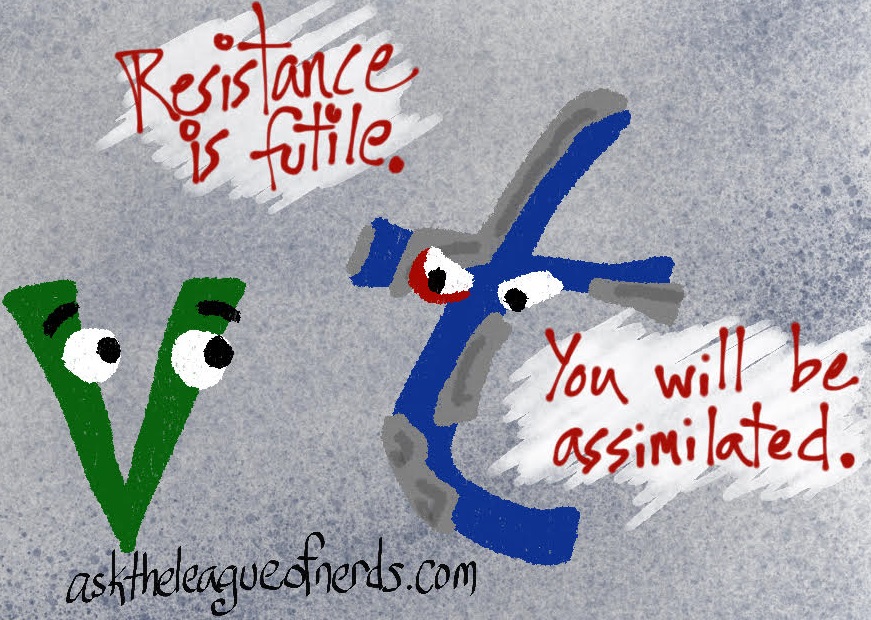Why is it that when people say “have to” as two words it’s got a “v,” but when they run it together it’s an “f,” “hafta”?
-FML
***
Dear… really? FYL? Bummer.
They mostly don’t say “have to” with a “v” in the first place. “I have six cows” has a “v,” or “I have a ton of work to do,” but “I have to go” is still pretty likely to have an “f” sound.* And it’s because of that following “t.”
This particular sound change is called assimilation, a la the Borg. It’s when one sound changes because of the sounds that come before or after it (or both).** And I’ll try to keep this post self-contained, y’all, but it’ll be easier if you’ve already read my intro to phonetics (parts one, two, and three).
When we’re blowing air out our language holes, we can either vibrate our vocal chords or not. Many letters come in pairs – b&p, f&v, k&g, s&z, t&d – where we have our mouths and tongues in the same shape, and the only difference is having or not having that vibration. Try it. Say “sssss” and “zzzzzz” for a while with your hand on your neck, and you can feel the buzzing in “zzz.”
In “hafta,” the “t” of “to” is voiceless, and the voiced “v” of “have” switches to voiceless “f” in sympathy. It’s the way the sounds work together. And it doesn’t hurt that “have to” is a frequent flyer in our speech, so we have no trouble recognizing it despite the “f.”
This happens consistently with past tense verbs, as I’ve mentioned before. Say “asked” and “bagged.” What sound does that “-ed” make in those two words? Two different sounds, that’s what. Voiceless “k” gets followed by voiceless “t,” and voiced “g” gets followed by voiced “d.”
Voicing isn’t the only method for assimilation, though. Think about “think.” The “n” there doesn’t really make an “nnn” sound. It makes the “ng” sound you usually hear in words like “going” and “coming.” Why? Because “n” is made up near the gums, while “ng” is made at the back of the mouth, in the same place “k” is made. Feel free to pause and stare up at the ceiling and be way too aware of your tongue as you work this out.
Sometimes when sounds from all around the mouth cluster up in a word, you’ll get elision. This means somebody gets dropped entirely, usually the somebody that’s furthest away from the rest of the group. This is why “asked” is sometimes “askt,” sometimes “ast” – “s” and “t” are made in the same spot, while that “k” is miles away, so it gets left out. Same idea with “twelfth.” Nobody pronounces that “f.”
All this natural talk is incredibly difficult for students of English as a second language, by the way, who are often taught spelling before pronunciation. If you’ve ever stood in front of a class of skeptical seven-year-olds and tried to tell them that, really, we say “VEJ-ta-ble” and “COMF-ter-ble,” then you know what I’m talking about.
Which reminds me of another assimilation/elision combo I’ve been seeing. It’s been around in spoken language for a minute, but I’ve only started seeing it written down in the last couple years, mostly on twitter and at the website of the magnificent Awesomely Luvvie. Take “talking about,” elide the “i” in “talking” and the “a” in “about,” and then assimilate that “ng” to the lips, where “b” is sounded. Hell yeah: “talmbout.”
Yours,
The Language Nerd
*I know some of you are out there now muttering “have to… haf to… have to…” It’s hard to be natural when you’re overthinking it. Go sidle up to a friend and nonchalantly ask what they have to do this weekend and see what happens.
**Some sound changes, like metathesis, are unmotivated – there’s no particular reason for the sounds to change, they just do. Today we’re doing motivated sound changes.
Got a language question? Ask the Language Nerd! asktheleagueofnerds@gmail.com
Twitter @AskTheLeague / facebook.com/asktheleagueofnerds
References! There’s plenty of intro stuff covering this, much of it aimed at ESL teachers. Gotta think these how-we-actually-say-it pronunciations through, if you want those kids to talk. “Asked” as an example is from this site, which has nice piecemeal chunks. The BBC has explanations of assimilation and elision (and linking!) in British English. And this paper by Christina Maxwell has a bare-bones explanation of these processes, plus an experiment about why these are so hard for ESL students (and that failure to teach these kinds of rules may be part of why foreign-language learners think native speakers talk too damn fast).
Plus — full disclosure — I am not a huge Star Trek fan and had to go double-check IMDB to get my Borg quotes. Look, it’s better than me drawing a little consonant yelling “Exterminate,” right?
